Grid-Scale Poverty Assessment by Integrating High-Resolution Nighttime Light and Spatial Big Data—A Case Study in the Pearl River Delta
Abstract
:1. Introduction
2. Case Study and Data
2.1. Study Area
2.2. Data
2.2.1. LuoJia 1-01
2.2.2. POI
2.2.3. Housing Price
3. Method
3.1. Big Data Poverty Index (BDPI)
3.2. Multidimensional Poverty Index (MPI)
3.3. Housing Price Estimation Based on Machine Learning
4. Results
4.1. BDPI Results
4.2. MPI Results
4.3. Comparison of Two Poverty Assessment Results
4.4. Grid-Scale BDPI-Based Poverty Assessment
5. Discussion and Conclusions
5.1. Advantages and Disadvantages of the BDPI
5.2. Policy Recommendations
5.3. Main Conclusions
Author Contributions
Funding
Data Availability Statement
Conflicts of Interest
References
- Andries, A.; Morse, S.; Murphy, R.J.; Sadhukhan, J.; Martinez-Hernandez, E.; Amezcua-Allieri, M.A.; Aburto, J. Potential of Using Night-Time Light to Proxy Social Indicators for Sustainable Development. Remote Sens. 2023, 15, 1209. [Google Scholar] [CrossRef]
- Asher, S.; Lunt, T.; Matsuura, R.; Novosad, P. Development Research at High Geographic Resolution: An Analysis of Night-Lights, Firms, and Poverty in India Using the SHRUG Open Data Platform. World Bank Econ. Rev. 2021, 35, 845–871. [Google Scholar] [CrossRef]
- Cecchini, S.; Savio, G.; Tromben, V. Mapping poverty rates in Chile with night lights and fractional multinomial models. Reg. Sci. Policy Pract. 2022, 14, 850–876. [Google Scholar] [CrossRef]
- Hall, O.; Dompae, F.; Wahab, I.; Dzanku, F.M. A review of machine learning and satellite imagery for poverty prediction: Implications for development research and applications. J. Int. Dev. 2023, 1–16. [Google Scholar] [CrossRef]
- Hutasavi, S.; Chen, D. Exploring the industrial growth and poverty alleviation through space-time data mining from night-time light images: A case study in Eastern Economic Corridor (EEC), Thailand. Int. J. Remote Sens. 2022, 1–23. [Google Scholar] [CrossRef]
- Wang, Y.; Wang, M.; Huang, B.; Li, S.; Lin, Y. Evaluation and Analysis of Poverty-Stricken Counties under the Framework of the UN Sustainable Development Goals: A Case Study of Hunan Province, China. Remote Sens. 2021, 13, 4778. [Google Scholar] [CrossRef]
- Hu, S.; Ge, Y.; Liu, M.; Ren, Z.; Zhang, X. Village-level poverty identification using machine learning, high-resolution images, and geospatial data. Int. J. Appl. Earth Obs. Geoinf. 2022, 107, 102694. [Google Scholar] [CrossRef]
- Liu, Y.; Liu, J.; Zhou, Y. Spatio-temporal patterns of rural poverty in China and targeted poverty alleviation strategies. J. Rural Stud. 2017, 52, 66–75. [Google Scholar] [CrossRef]
- Wang, W.; Cheng, H.; Zhang, L. Poverty assessment using DMSP/OLS night-time light satellite imagery at a provincial scale in China. Adv. Space Res. 2012, 49, 1253–1264. [Google Scholar] [CrossRef]
- Luo, E.; Kuffer, M.; Wang, J. Urban poverty maps—From characterising deprivation using geo-spatial data to capturing deprivation from space. Sustain. Cities Soc. 2022, 84, 104033. [Google Scholar] [CrossRef]
- Määttä, I.; Ferreira, T.; Leßmann, C. Nighttime lights and wealth in very small areas. Rev. Reg. Res. 2022, 42, 161–190. [Google Scholar] [CrossRef]
- Xu, L.; Deng, X.; Jiang, Q.O.; Ma, F. Identification and alleviation pathways of multidimensional poverty and relative poverty in counties of China. J. Geogr. Sci. 2021, 31, 1715–1736. [Google Scholar] [CrossRef]
- Tselios, V.; Stathakis, D.; Faraslis, I. Concentration of populations and economic activities, growth, and convergence in Europe using satellite-observed lighting. Geocarto Int. 2020, 35, 1527–1552. [Google Scholar] [CrossRef]
- Tarozzi, A.; Deaton, A. Using Census and Survey Data to Estimate Poverty and Inequality for Small Areas. Rev. Econ. Stat. 2009, 91, 773–792. [Google Scholar] [CrossRef]
- Gu, Z.; Zhao, X.; Huang, P.; Pu, J.; Shi, X.; Li, Y. Identification of Multi-Dimensional Relative Poverty and Governance Path at the Village Scale in an Alpine-Gorge Region: A Case Study in Nujiang, China. Int. J. Environ. Res. Public Health 2023, 20, 1286. [Google Scholar] [CrossRef] [PubMed]
- Li, G.; Cai, Z.; Liu, X.; Liu, J.; Su, S. A comparison of machine learning approaches for identifying high-poverty counties: Robust features of DMSP/OLS night-time light imagery. Int. J. Remote Sens. 2019, 40, 5716–5736. [Google Scholar] [CrossRef]
- Mahabir, R.; Agouris, P.; Stefanidis, A.; Croitoru, A.; Crooks, A.T. Detecting and mapping slums using open data: A case study in Kenya. Int. J. Digit. Earth 2020, 13, 683–707. [Google Scholar] [CrossRef]
- Small, C.; Sousa, D.; Yetman, G.; Elvidge, C.; MacManus, K. Decades of urban growth and development on the Asian megadeltas. Glob. Planet. Chang. 2018, 165, 62–89. [Google Scholar] [CrossRef]
- Chen, R.; Zhang, F.; Chan, N.W.; Wang, Y. Multidimensional poverty measurement and spatial–temporal pattern analysis at county level in the arid area of Xinjiang, China. Environ. Dev. Sustain. 2022, 1–20. [Google Scholar] [CrossRef]
- Han, Y.; Liu, L.; Sui, Q.; Zhou, J. Big Data Spatio-Temporal Correlation Analysis and LRIM Model Based Targeted Poverty Alleviation through Education. ISPRS Int. J. Geo-Inf. 2021, 10, 837. [Google Scholar] [CrossRef]
- Ke, N.; Lu, X.; Kuang, B.; Zhang, X. Regional disparities and evolution trend of city-level carbon emission intensity in China. Sustain. Cities Soc. 2023, 88, 104288. [Google Scholar] [CrossRef]
- Ma, L.; Che, X.; Zhang, J.; Fang, F.; Chen, M. Rural Poverty Identification and Comprehensive Poverty Assessment Based on Quality-of-Life: The Case of Gansu Province (China). Sustainability 2019, 11, 4547. [Google Scholar] [CrossRef]
- Su, S.; Gong, Y.; Tan, B.; Pi, J.; Weng, M.; Cai, Z. Area Social Deprivation and Public Health: Analyzing the Spatial Non-stationary Associations Using Geographically Weighed Regression. Soc. Indic. Res. 2017, 133, 819–832. [Google Scholar] [CrossRef]
- Sun, J.; Di, L.; Sun, Z.; Wang, J.; Wu, Y. Estimation of GDP Using Deep Learning With NPP-VIIRS Imagery and Land Cover Data at the County Level in CONUS. IEEE J. Sel. Top. Appl. Earth Obs. Remote Sens. 2020, 13, 1400–1415. [Google Scholar] [CrossRef]
- Li, G.; Cai, Z.; Liu, J.; Liu, X.; Su, S.; Huang, X.; Li, B. Multidimensional Poverty in Rural China: Indicators, Spatiotemporal Patterns and Applications. Soc. Indic. Res. 2019, 144, 1099–1134. [Google Scholar] [CrossRef]
- Jean, N.; Burke, M.; Xie, M.; Davis, W.M.; Lobell, D.B.; Ermon, S. Combining satellite imagery and machine learning to predict poverty. Science 2016, 353, 790–794. [Google Scholar] [CrossRef]
- Elvidge, C.D.; Sutton, P.C.; Ghosh, T.; Tuttle, B.T.; Baugh, K.E.; Bhaduri, B.; Bright, E. A global poverty map derived from satellite data. Comput. Geosci. 2009, 35, 1652–1660. [Google Scholar] [CrossRef]
- Sutton, P.C.; Elvidge, C.D.; Ghosh, T. Estimation of Gross Domestic Product at Sub-National Scales using Nighttime Satellite Imagery. Int. J. Ecol. Econ. Stat. 2007, 8, 5–21. [Google Scholar]
- Levin, N.; Zhang, Q. A global analysis of factors controlling VIIRS nighttime light levels from densely populated areas. Remote Sens. Environ. 2017, 190, 366–382. [Google Scholar] [CrossRef]
- Pandey, B.; Joshi, P.K.; Seto, K.C. Monitoring urbanization dynamics in India using DMSP/OLS night time lights and SPOT-VGT data. Int. J. Appl. Earth Obs. Geoinf. 2013, 23, 49–61. [Google Scholar] [CrossRef]
- Zhuo, L.; Shi, Q.; Tao, H.; Zheng, J.; Li, Q. An improved temporal mixture analysis unmixing method for estimating impervious surface area based on MODIS and DMSP-OLS data. ISPRS J. Photogramm. Remote Sens. 2018, 142, 64–77. [Google Scholar] [CrossRef]
- Zhang, Q.; Seto, K.C. Mapping urbanization dynamics at regional and global scales using multi-temporal DMSP/OLS nighttime light data. Remote Sens. Environ. 2011, 115, 2320–2329. [Google Scholar] [CrossRef]
- Bennett, M.M.; Smith, L.C. Advances in using multitemporal night-time lights satellite imagery to detect, estimate, and monitor socioeconomic dynamics. Remote Sens. Environ. 2017, 192, 176–197. [Google Scholar] [CrossRef]
- Cao, X.; Wang, J.; Chen, J.; Shi, F. Spatialization of electricity consumption of China using saturation-corrected DMSP-OLS data. Int. J. Appl. Earth Obs. Geoinf. 2014, 28, 193–200. [Google Scholar] [CrossRef]
- Elvidge, C.D.; Baugh, K.; Zhizhin, M.; Hsu, F.C.; Ghosh, T. VIIRS night-time lights. Int. J. Remote Sens. 2017, 38, 5860–5879. [Google Scholar] [CrossRef]
- Ghosh, T.; Anderson, S.J.; Elvidge, C.D.; Sutton, P.C. Using Nighttime Satellite Imagery as a Proxy Measure of Human Well-Being. Sustainability 2013, 5, 4988–5019. [Google Scholar] [CrossRef]
- He, C.; Ma, Q.; Liu, Z.; Zhang, Q. Modeling the spatiotemporal dynamics of electric power consumption in Mainland China using saturation-corrected DMSP/OLS nighttime stable light data. Int. J. Digit. Earth 2014, 7, 993–1014. [Google Scholar] [CrossRef]
- Ma, T.; Zhou, C.; Pei, T.; Haynie, S.; Fan, J. Responses of Suomi-NPP VIIRS-derived nighttime lights to socioeconomic activity in China’s cities. Remote Sens. Lett. 2014, 5, 165–174. [Google Scholar] [CrossRef]
- Mellander, C.; Lobo, J.; Stolarick, K.; Matheson, Z. Night-Time Light Data: A Good Proxy Measure for Economic Activity? PLoS ONE 2015, 10, e0139779. [Google Scholar] [CrossRef]
- Pan, J.; Li, J. Spatiotemporal Dynamics of Electricity Consumption in China. Appl. Spat. Anal. Policy 2019, 12, 395–422. [Google Scholar] [CrossRef]
- Yong, Z.; Li, K.; Xiong, J.; Cheng, W.; Wang, Z.; Sun, H.; Ye, C. Integrating DMSP-OLS and NPP-VIIRS Nighttime Light Data to Evaluate Poverty in Southwestern China. Remote Sens. 2022, 14, 600. [Google Scholar] [CrossRef]
- Liu, H.; Wang, J.; Liu, H.; Chen, Y.; Liu, X.; Guo, Y.; Huang, H. Identification of Relative Poverty Based on 2012-2020 NPP/VIIRS Night Light Data: In the Area Surrounding Beijing and Tianjin in China. Sustainability 2022, 14, 5559. [Google Scholar] [CrossRef]
- Yu, B.; Shi, K.; Hu, Y.; Huang, C.; Chen, Z.; Wu, J. Poverty Evaluation Using NPP-VIIRS Nighttime Light Composite Data at the County Level in China. IEEE J. Sel. Top. Appl. Earth Obs. Remote Sens. 2015, 8, 1217–1229. [Google Scholar] [CrossRef]
- Pan, J.; Hu, Y. Spatial Identification of Multi-dimensional Poverty in Rural China: A Perspective of Nighttime-Light Remote Sensing Data. J. Indian Soc. Remote Sens. 2018, 46, 1093–1111. [Google Scholar] [CrossRef]
- Coscieme, L.; Sutton, P.C.; Anderson, S.; Liu, Q.; Elvidge, C.D. Dark Times: Nighttime satellite imagery as a detector of regional disparity and the geography of conflict. GISci. Remote Sens. 2017, 54, 118–139. [Google Scholar] [CrossRef]
- Georganos, S.; Abascal, A.; Kuffer, M.; Wang, J.; Owusu, M.; Wolff, E.; Vanhuysse, S. Is It All the Same? Mapping and Characterizing Deprived Urban Areas Using WorldView-3 Superspectral Imagery. A Case Study in Nairobi, Kenya. Remote Sens. 2021, 13, 4986. [Google Scholar] [CrossRef]
- Gibson, J.; Olivia, S.; Boe-Gibson, G.; Li, C. Which night lights data should we use in economics, and where? J. Dev. Econ. 2021, 149, 102602. [Google Scholar] [CrossRef]
- Proville, J.; Zavala-Araiza, D.; Wagner, G. Night-time lights: A global, long term look at links to socio-economic trends. PLoS ONE 2017, 12, e0174610. [Google Scholar] [CrossRef]
- Putri, S.R.; Wijayanto, A.W.; Sakti, A.D. Developing Relative Spatial Poverty Index Using Integrated Remote Sensing and Geospatial Big Data Approach: A Case Study of East Java, Indonesia. ISPRS Int. J. Geo-Inf. 2022, 11, 275. [Google Scholar] [CrossRef]
- Puttanapong, N.; Martinez, A.; Bulan, J.A.N.; Addawe, M.; Durante, R.L.; Martillan, M. Predicting Poverty Using Geospatial Data in Thailand. ISPRS Int. J. Geo-Inf. 2022, 11, 293. [Google Scholar] [CrossRef]
- Chen, Q.; Ye, T.; Zhao, N.; Ding, M.; Ouyang, Z.; Jia, P.; Yue, W.; Yang, X. Mapping China’s regional economic activity by integrating points-of-interest and remote sensing data with random forest. Environ. Plan. B Urban Anal. City Sci. 2021, 48, 1876–1894. [Google Scholar] [CrossRef]
- Du, X.; Shen, L.; Wong, S.W.; Meng, C.; Yang, Z. Night-time light data based decoupling relationship analysis between economic growth and carbon emission in 289 Chinese cities. Sustain. Cities Soc. 2021, 73, 103119. [Google Scholar] [CrossRef]
- Roy Chowdhury, P.K.; Weaver, J.E.; Weber, E.M.; Lunga, D.; LeDoux, S.T.M.; Rose, A.N.; Bhaduri, B.L. Electricity consumption patterns within cities: Application of a data-driven settlement characterization method. Int. J. Digit. Earth 2020, 13, 119–135. [Google Scholar] [CrossRef]
- Pokhriyal, N.; Jacques, D.C. Combining disparate data sources for improved poverty prediction and mapping. Proc. Natl. Acad. Sci. USA 2017, 114, E9783–E9792. [Google Scholar] [CrossRef] [PubMed]
- Guo, W.; Zhang, J.; Zhao, X.; Li, Y.; Liu, J.; Sun, W.; Fan, D. Combining Luojia1-01 Nighttime Light and Points-of-Interest Data for Fine Mapping of Population Spatialization Based on the Zonal Classification Method. IEEE J. Sel. Top. Appl. Earth Obs. Remote Sens. 2023, 16, 1589–1600. [Google Scholar] [CrossRef]
- Davis, M.A.; Ortalo-Magné, F. Household expenditures, wages, rents. Rev. Econ. Dyn. 2011, 14, 248–261. [Google Scholar] [CrossRef]
- Partridge, M.D.; Rickman, D.S.; Ali, K.; Olfert, M.R. Recent spatial growth dynamics in wages and housing costs: Proximity to urban production externalities and consumer amenities. Reg. Sci. Urban Econ. 2010, 40, 440–452. [Google Scholar] [CrossRef]
- Ni, Y.; Li, X.; Ye, Y.; Li, Y.; Li, C.; Chu, D. An Investigation on Deep Learning Approaches to Combining Nighttime and Daytime Satellite Imagery for Poverty Prediction. IEEE Geosci. Remote Sens. Lett. 2021, 18, 1545–1549. [Google Scholar] [CrossRef]
- Shi, K.; Chang, Z.; Chen, Z.; Wu, J.; Yu, B. Identifying and evaluating poverty using multisource remote sensing and point of interest (POI) data: A case study of Chongqing, China. J. Clean. Prod. 2020, 255, 120245. [Google Scholar] [CrossRef]
- Lin, J.; Luo, S.; Huang, Y. Poverty estimation at the county level by combining LuoJia1-01 nighttime light data and points of interest. Geocarto Int. 2022, 37, 3590–3606. [Google Scholar] [CrossRef]
- Lin, L.; Di, L.; Zhang, C.; Guo, L.; Di, Y. Remote Sensing of Urban Poverty and Gentrification. Remote Sens. 2021, 13, 4022. [Google Scholar] [CrossRef]
- Ma, T. Quantitative responses of satellite-derived night-time light signals to urban depopulation during Chinese New Year. Remote Sens. Lett. 2019, 10, 139–148. [Google Scholar] [CrossRef]
- Shi, K.; Wu, Y.; Liu, S.; Chen, Z.; Huang, C.; Cui, Y. Mapping and evaluating global urban entities (2000–2020): A novel perspective to delineate urban entities based on consistent nighttime light data. GIScience Remote Sens. 2023, 60, 2161199. [Google Scholar] [CrossRef]
- Tan, Y.; Wu, P.; Zhou, G.; Li, Y.; Bai, B. Combining Residual Neural Networks and Feature Pyramid Networks to Estimate Poverty Using Multisource Remote Sensing Data. IEEE J. Sel. Top. Appl. Earth Obs. Remote Sens. 2020, 13, 553–565. [Google Scholar] [CrossRef]
- Wu, J.; Wang, Z.; Li, W.; Peng, J. Exploring factors affecting the relationship between light consumption and GDP based on DMSP/OLS nighttime satellite imagery. Remote Sens. Environ. 2013, 134, 111–119. [Google Scholar] [CrossRef]
- Xu, J.; Song, J.; Li, B.; Liu, D.; Cao, X. Combining night time lights in prediction of poverty incidence at the county level. Appl. Geogr. 2021, 135, 102552. [Google Scholar] [CrossRef]
- Wang, K.; Zhang, L.; Cai, M.; Liu, L.; Wu, H.; Peng, Z. Measuring Urban Poverty Spatial by Remote Sensing and Social Sensing Data: A Fine-Scale Empirical Study from Zhengzhou. Remote Sens. 2023, 15, 381. [Google Scholar] [CrossRef]
- Xu, Y.; Mo, Y.; Zhu, S. Poverty Mapping in the Dian-Gui-Qian Contiguous Extremely Poor Area of Southwest China Based on Multi-Source Geospatial Data. Sustainability 2021, 13, 8717. [Google Scholar] [CrossRef]
- Yin, J.; Qiu, Y.; Zhang, B. Identification of Poverty Areas by Remote Sensing and Machine Learning: A Case Study in Guizhou, Southwest China. ISPRS Int. J. Geo-Inf. 2021, 10, 11. [Google Scholar] [CrossRef]
- Zhao, X.; Yu, B.; Liu, Y.; Chen, Z.; Li, Q.; Wang, C.; Wu, J. Estimation of Poverty Using Random Forest Regression with Multi-Source Data: A Case Study in Bangladesh. Remote Sens. 2019, 11, 375. [Google Scholar] [CrossRef]
- Zhao, N.; Liu, Y.; Hsu, F.-C.; Samson, E.L.; Letu, H.; Liang, D.; Cao, G. Time series analysis of VIIRS-DNB nighttime lights imagery for change detection in urban areas: A case study of devastation in Puerto Rico from hurricanes Irma and Maria. Appl. Geogr. 2020, 120, 102222. [Google Scholar] [CrossRef]
- Kraff, N.J.; Wurm, M.; Taubenböck, H. Housing forms of poverty in Europe—A categorization based on literature research and satellite imagery. Appl. Geogr. 2022, 149, 102820. [Google Scholar] [CrossRef]
- Delang, C.O.; Lung, H.C. Public Housing and Poverty Concentration in Urban Neighbourhoods: The Case of Hong Kong in the 1990s. Urban Stud. 2010, 47, 1391–1413. [Google Scholar] [CrossRef]
- Zhang, P.; Hu, S.; Li, W.; Zhang, C.; Yang, S.; Qu, S. Modeling fine-scale residential land price distribution: An experimental study using open data and machine learning. Appl. Geogr. 2021, 129, 102442. [Google Scholar] [CrossRef]
- Yi, C.; Huang, Y. Housing Consumption and Housing Inequality in Chinese Cities During the First Decade of the Twenty-First Century. Hous. Stud. 2014, 29, 291–311. [Google Scholar] [CrossRef]
- Zhou, X.; Tong, W.; Li, D. Modeling Housing Rent in the Atlanta Metropolitan Area Using Textual Information and Deep Learning. ISPRS Int. J. Geo-Inf. 2019, 8, 349. [Google Scholar] [CrossRef]
- Yao, Y.; Zhang, J.; Hong, Y.; Liang, H.; He, J. Mapping fine-scale urban housing prices by fusing remotely sensed imagery and social media data. Trans. GIS 2018, 22, 561–581. [Google Scholar] [CrossRef]
- Lin, J.; Qiu, S.; Tan, X.; Zhuang, Y. Measuring the relationship between morphological spatial pattern of green space and urban heat island using machine learning methods. Build. Environ. 2023, 228, 109910. [Google Scholar] [CrossRef]
- Yuan, Y.; Wu, F. The development of the index of multiple deprivations from small-area population census in the city of Guangzhou, PRC. Habitat Int. 2014, 41, 142–149. [Google Scholar] [CrossRef]
- Chen, Q.; Hou, X.; Zhang, X.; Ma, C. Improved GDP spatialization approach by combining land-use data and night-time light data: A case study in China’s continental coastal area. Int. J. Remote Sens. 2016, 37, 4610–4622. [Google Scholar] [CrossRef]
- Lin, J.; Zhang, W.; Wen, Y.; Qiu, S. Evaluating the association between morphological characteristics of urban land and pluvial floods using machine learning methods. Sustain. Cities Soc. 2023, 104891. [Google Scholar] [CrossRef]
- Li, C.; Yang, W.; Tang, Q.; Tang, X.; Lei, J.; Wu, M.; Qiu, S. Detection of Multidimensional Poverty Using Luojia 1-01 Nighttime Light Imagery. J. Indian Soc. Remote Sens. 2020, 48, 963–977. [Google Scholar] [CrossRef]
- Li, X.; Li, X.; Li, D.; He, X.; Jendryke, M. A preliminary investigation of Luojia-1 night-time light imagery. Remote Sens. Lett. 2019, 10, 526–535. [Google Scholar] [CrossRef]
- Zhang, G.; Guo, X.; Li, D.; Jiang, B. Evaluating the Potential of LJ1-01 Nighttime Light Data for Modeling Socio-Economic Parameters. Sensors 2019, 19, 1465. [Google Scholar] [CrossRef] [PubMed]
- Li, X.; Zhao, L.; Li, D.; Xu, H. Mapping Urban Extent Using Luojia 1-01 Nighttime Light Imagery. Sensors 2018, 18, 3665. [Google Scholar] [CrossRef] [PubMed]
- Lu, Y.; Liang, Y.; Lu, S.; Xiao, Y.; He, X.; Lin, J. Spatialization of carbon emissions in Guangzhou City by combining Luojia1-01 nighttime light and urban functional zoning data. J. Geo-Inf. Sci. 2022, 24, 1176–1188. [Google Scholar] [CrossRef]
- Zhang, G.; Li, L.; Jiang, Y.; Shen, X.; Li, D. On-Orbit Relative Radiometric Calibration of the Night-Time Sensor of the LuoJia1-01 Satellite. Sensors 2018, 18, 4225. [Google Scholar] [CrossRef]
- Guo, W.; Li, G.; Ni, W.; Zhang, Y.; Lu, D. Exploring improvement of impervious surface estimation at national scale through integration of nighttime light and Proba-V data. GIScience Remote Sens. 2018, 55, 699–717. [Google Scholar] [CrossRef]
- Niu, T.; Chen, Y.; Yuan, Y. Measuring urban poverty using multi-source data and a random forest algorithm: A case study in Guangzhou. Sustain. Cities Soc. 2020, 54, 102014. [Google Scholar] [CrossRef]
- Meng, Y.; Xing, H.; Yuan, Y.; Wong, M.S.; Fan, K. Sensing urban poverty: From the perspective of human perception-based greenery and open-space landscapes. Comput. Environ. Urban Syst. 2020, 84, 101544. [Google Scholar] [CrossRef]
- Truong, Q.; Nguyen, M.; Dang, H.; Mei, B. Housing Price Prediction via Improved Machine Learning Techniques. Procedia Comput. Sci. 2020, 174, 433–442. [Google Scholar] [CrossRef]
- Rana, V.S.; Mondal, J.; Sharma, A.; Kashyap, I. House Price Prediction Using Optimal Regression Techniques. In Proceedings of the 2020 2nd International Conference on Advances in Computing, Communication Control and Networking (ICACCCN), Greater Noida, India, 18–19 December 2020; pp. 203–208. [Google Scholar]
- Stevens, F.R.; Gaughan, A.E.; Linard, C.; Tatem, A.J. Disaggregating Census Data for Population Mapping Using Random Forests with Remotely-Sensed and Ancillary Data. PLoS ONE 2015, 10, e0107042. [Google Scholar] [CrossRef] [PubMed]
- Zeng, J.; Zhang, R.; Tang, J.; Liang, J.; Li, J.; Zeng, Y.; Li, Y.; Zhang, Q.; Shui, W.; Wang, Q. Ecological sustainability assessment of the carbon footprint in Fujian Province, southeast China. Front. Earth Sci. 2021, 15, 12–22. [Google Scholar] [CrossRef]
- Breiman, L. Random Forests. Mach. Learn. 2001, 45, 5–32. [Google Scholar] [CrossRef]
- Li, H.; Peng, Y.; Li, M.; Zhuang, Y.; He, X.; Lin, J. Analyzing spatial patterns and influencing factors of different illegal land use types within ecological spaces: A case study of a fast-growing city. J. Clean. Prod. 2023, 138883. [Google Scholar] [CrossRef]
- Interpret the Key Results for Principal Components Analysis. Available online: https://support.minitab.com/en-us/minitab/21/help-and-how-to/statistical-modeling/multivariate/how-to/principal-components/interpret-the-results/key-results/ (accessed on 6 May 2023).

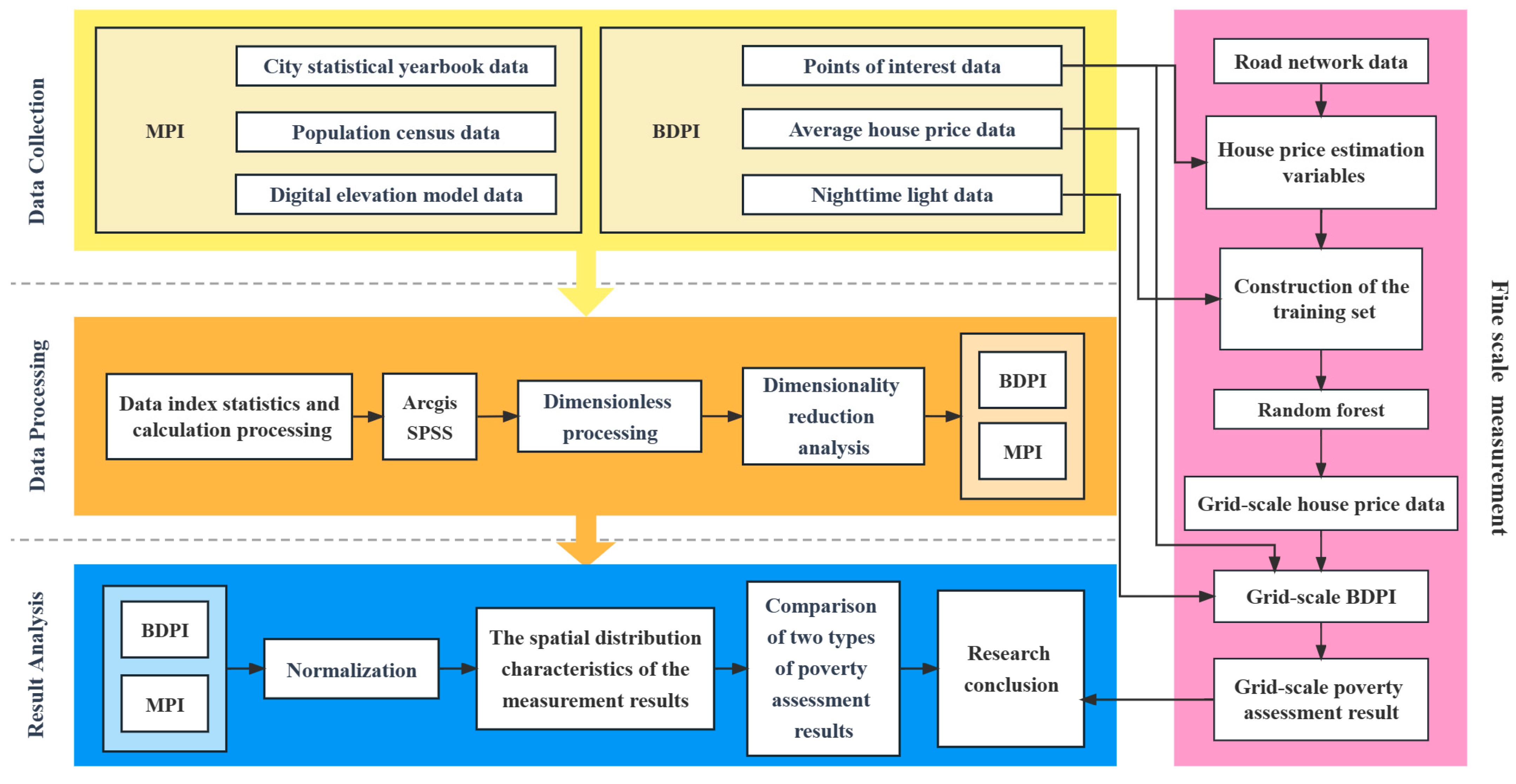
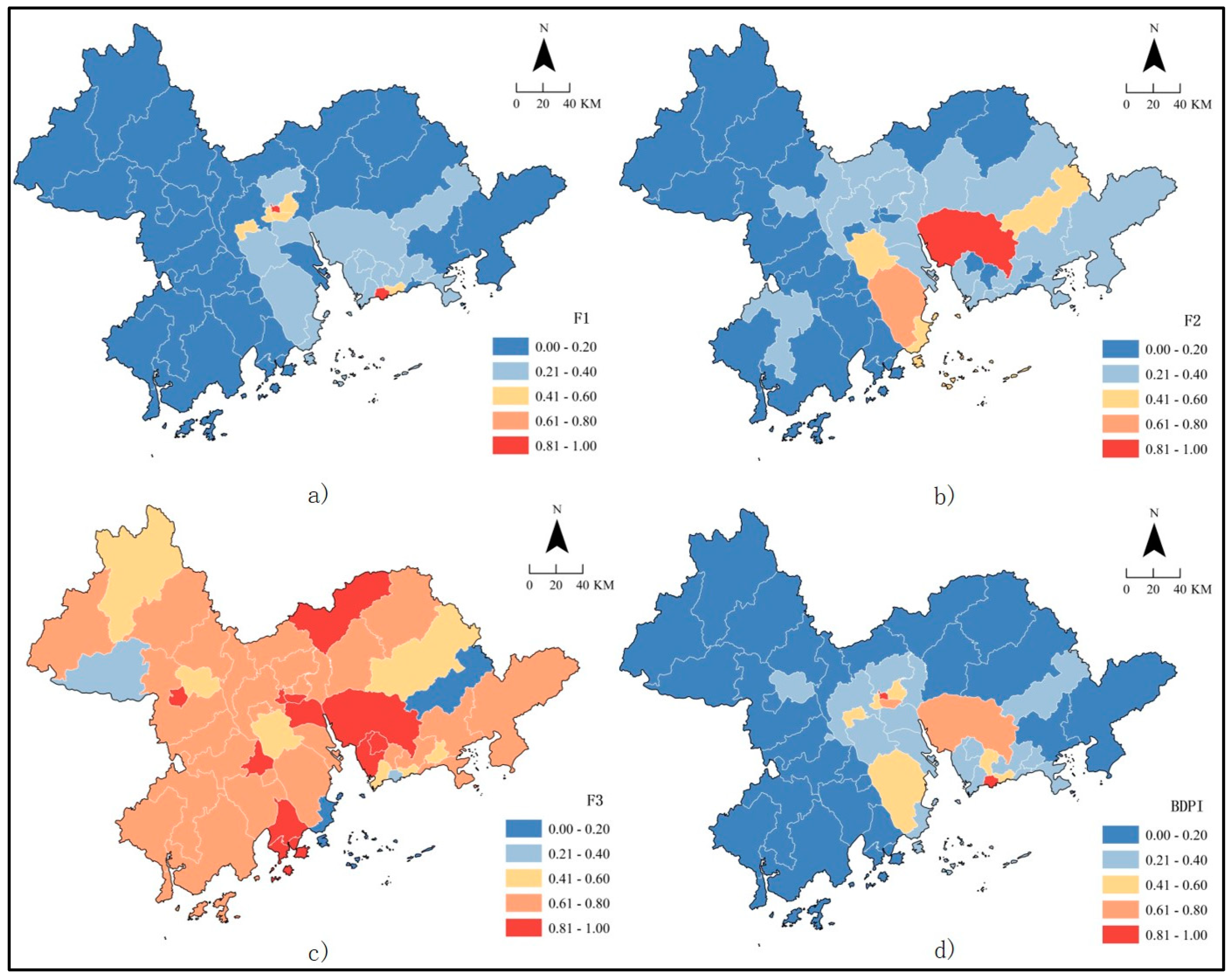

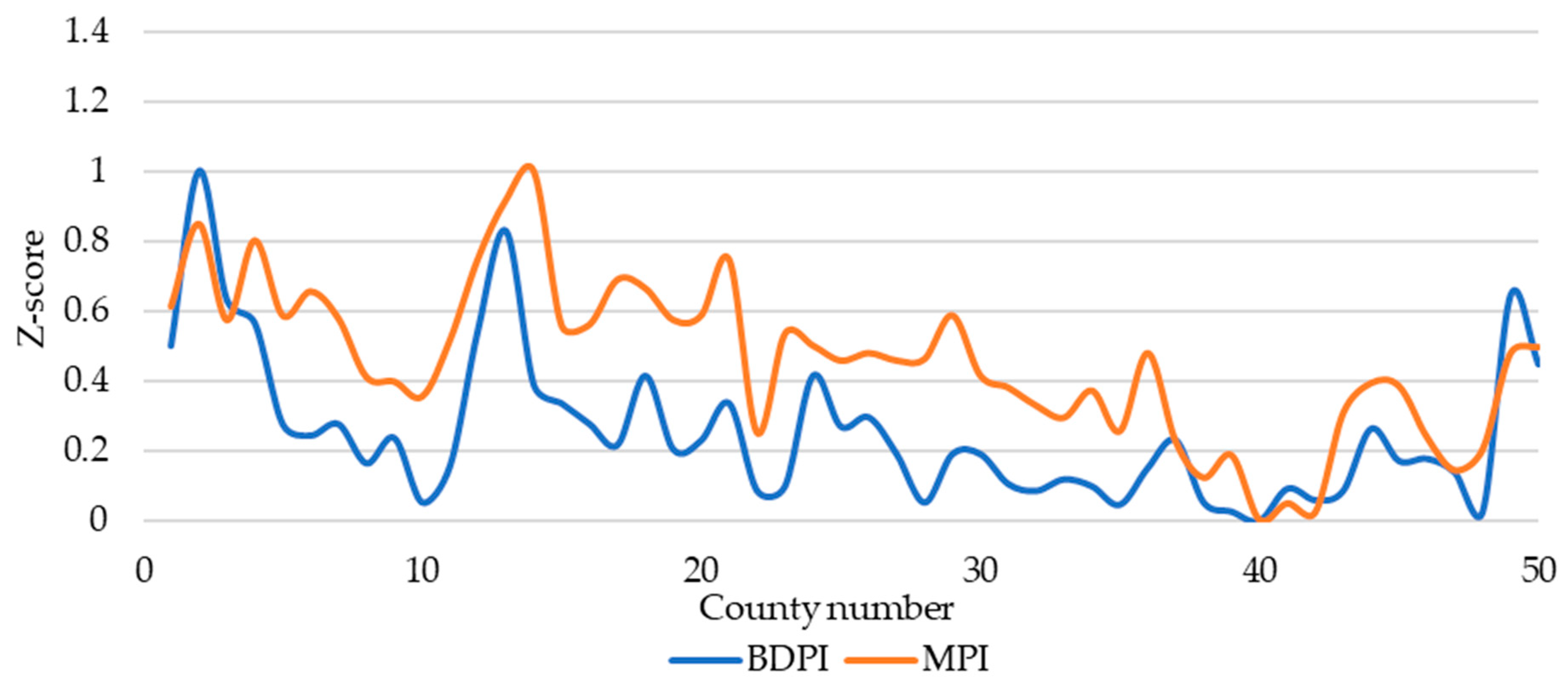
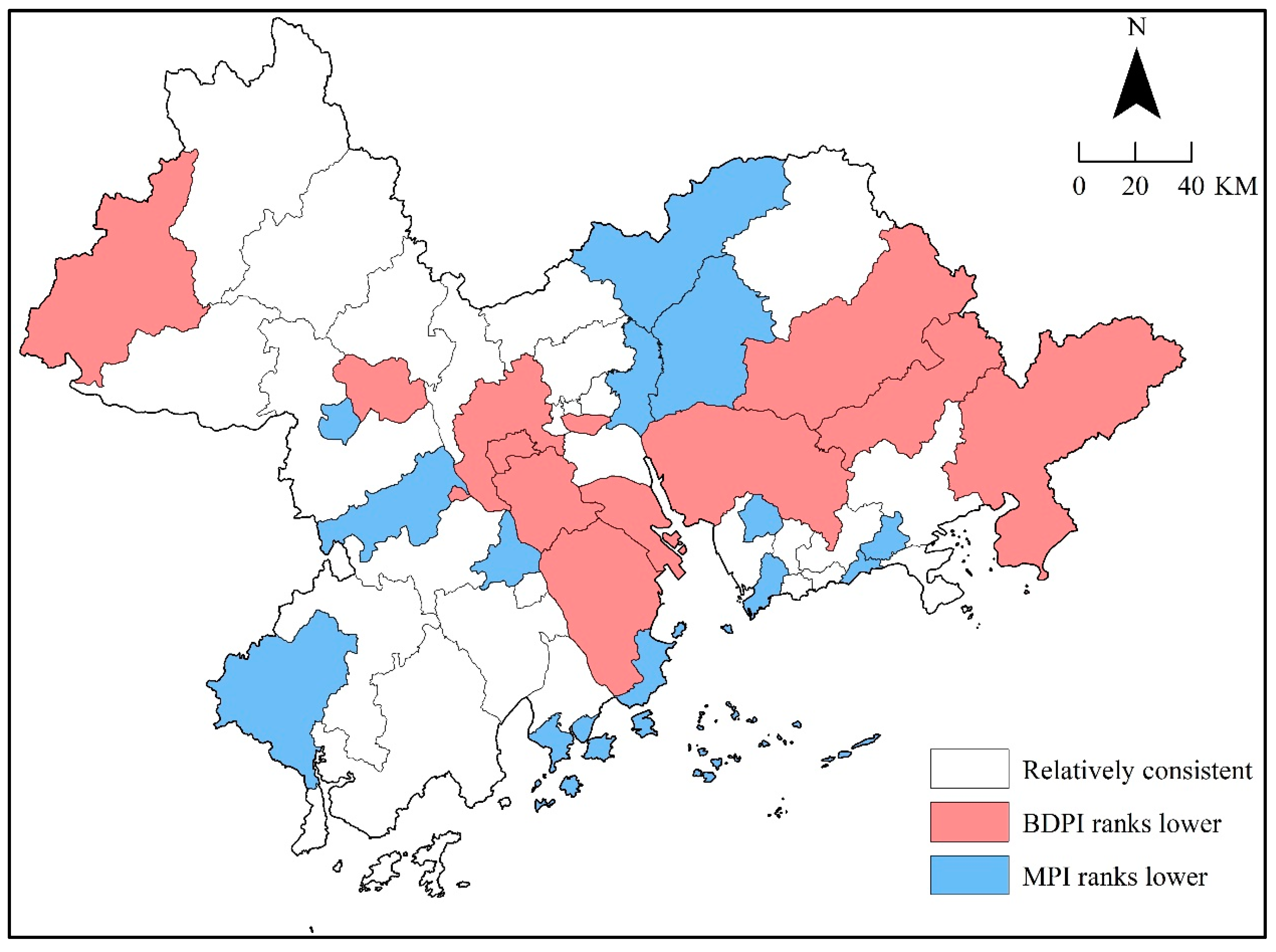
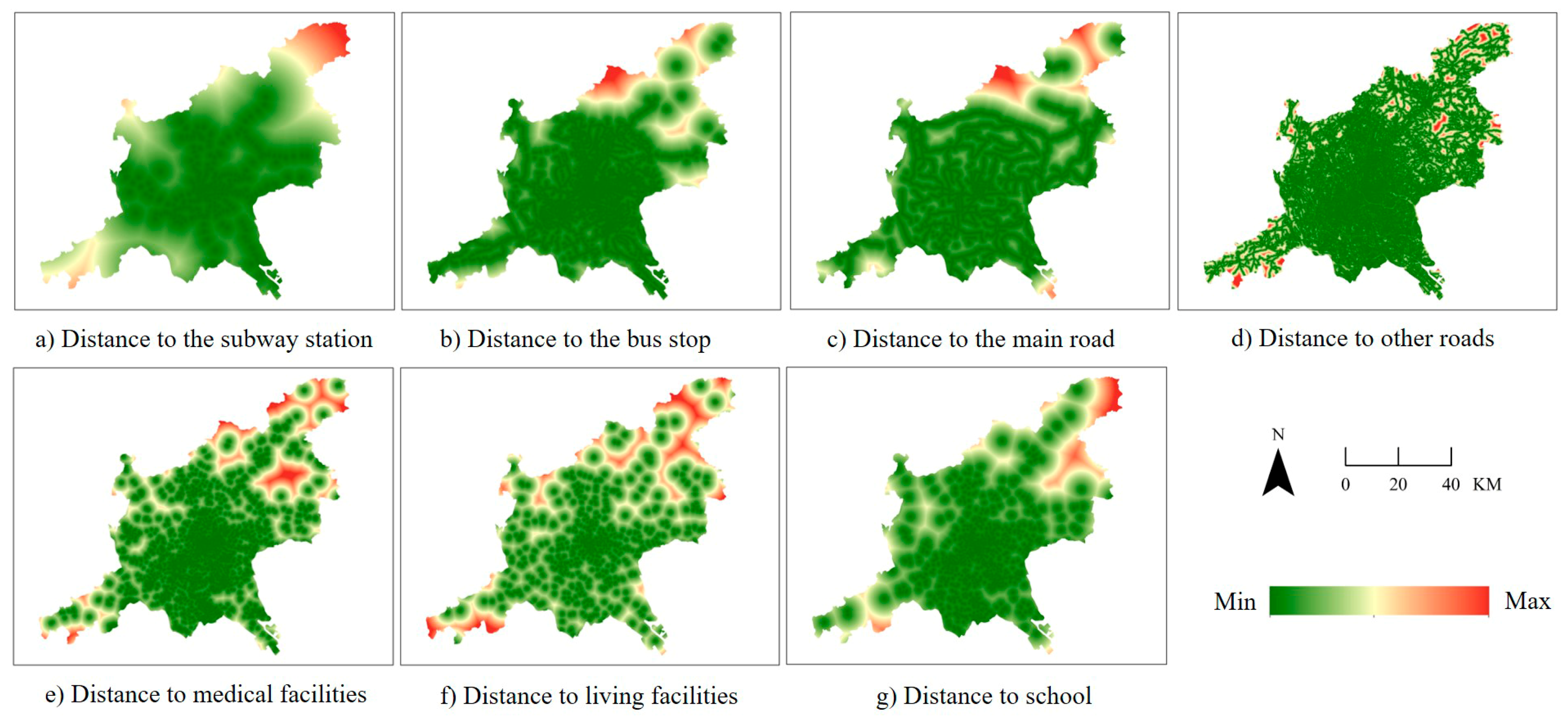
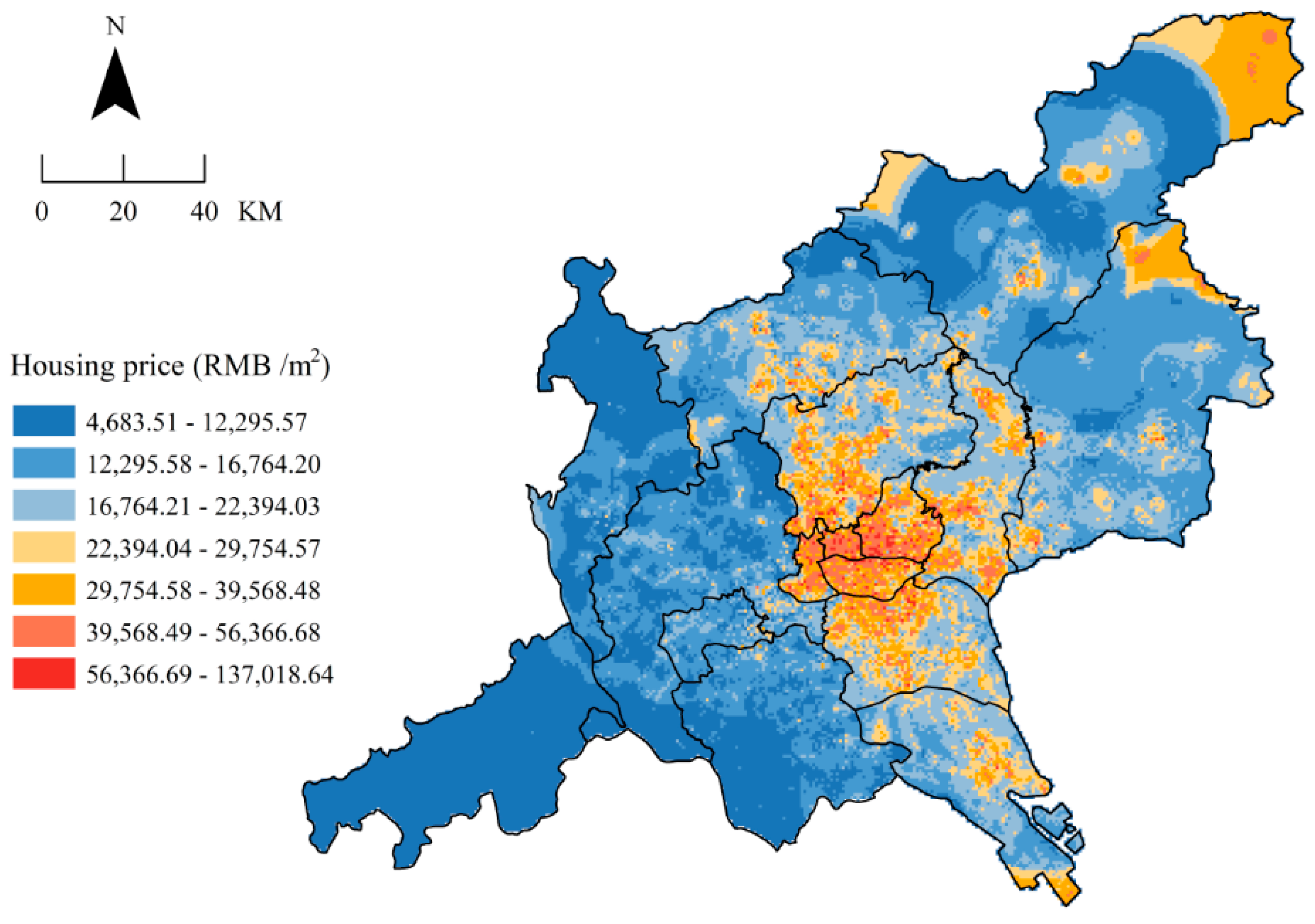

| Indicator | Explanation |
|---|---|
| Average value | L/G, L means the total values of all land use grids, G means the number of grids |
| Average light index | L/, means the number of land use grids in lighting parts |
| Standard deviation | means the value for the ith grid, means the average score for every grid |
| Maximum value | Maximum value for every land use grid |
| Moran’s I Index | Relationship between pixel light values for each county, which represents spatial correlation |
| KMO | 0.635 | |
|---|---|---|
| Bartlett’s test | Degree of freedom | 55 |
| Significance | 0.000 | |
| Category | Indicator | Principal Component | ||
|---|---|---|---|---|
| First | Second | Third | ||
| Nighttime light | Mean | 0.952 | ||
| Maximum | 0.639 | |||
| Standard Deviation | 0.847 | |||
| Sum | 0.890 | |||
| Moran’s I Index | −0.603 | |||
| POI | Corporates | |||
| Scenic spots | 0.875 | |||
| Scientific, educational and cultural services | 0.689 | |||
| Transportation facilities | 0.938 | |||
| Living and leisure services | 0.930 | |||
| Housing price | Average housing price | −0.836 | ||
| Eigenvalue of the principal component | 5.690 | 1.812 | 1.294 | |
| Contribution rate of the principal component (%) | 51.729 | 16.473 | 11.763 | |
| Cumulative contribution rate of the principal components (%) | 51.729 | 68.202 | 79.964 | |
| KMO | 0.794 | |
|---|---|---|
| Bartlett’s test | Degree of freedom | 136 |
| Significance | 0.000 | |
| Indicator | Principal Component | ||||
|---|---|---|---|---|---|
| First | Second | Third | Fourth | Fifth | |
| Population aged 0–14 years and over 65 years old | 0.917 | ||||
| Rural population | 0.894 | ||||
| Ethnic minority population | −0.595 | ||||
| Proportion of population with primary education | −0.861 | ||||
| Proportion of population with secondary education | −0.908 | ||||
| Proportion of population with college or higher education | 0.800 | ||||
| Illiterate population over 15 years old | 0.829 | ||||
| Average years of education completed | 0.737 | ||||
| Number of professional technicians | 0.764 | ||||
| Number of people engaged in agriculture, forestry, animal husbandry and fishery | 0.914 | ||||
| Number of tertiary sectors | 0.873 | ||||
| Income in local government budget | 0.807 | ||||
| Proportion of jobholders | 0.587 | ||||
| Average elevation | 0.948 | ||||
| Average topographic relief | 0.926 | ||||
| Proportion of areas with slopes greater than 15° | 0.901 | ||||
| Average precipitation | 0.954 | ||||
| Eigenvalue of the principal component | 7.905 | 2.852 | 2.283 | 1.199 | 0.978 |
| Rotated variance contribution rate of the principal component (%) | 33.996 | 25.051 | 16.420 | 7.075 | 6.965 |
| Cumulative variance contribution rate of the principal component (%) | 33.996 | 59.047 | 75.466 | 82.541 | 89.506 |
| Top N% | City | Number of Impoverished County | |
|---|---|---|---|
| BDPI | MPI | ||
| Top 20% | Guangzhou | 1 | 0 |
| Dongguan | 0 | 0 | |
| Zhongshan | 0 | 0 | |
| Foshan | 1 | 0 | |
| Huizhou | 1 | 3 | |
| Jiangmen | 1 | 0 | |
| Shenzhen | 0 | 0 | |
| Zhuhai | 1 | 1 | |
| ZhaoQing | 5 | 6 | |
| Top 30% | Guangzhou | 1 | 1 |
| Dongguan | 0 | 0 | |
| Zhongshan | 0 | 0 | |
| Foshan | 1 | 0 | |
| Huizhou | 1 | 3 | |
| Jiangmen | 4 | 3 | |
| Shenzhen | 0 | 0 | |
| Zhuhai | 2 | 1 | |
| Zhaoqing | 6 | 7 | |
Disclaimer/Publisher’s Note: The statements, opinions and data contained in all publications are solely those of the individual author(s) and contributor(s) and not of MDPI and/or the editor(s). MDPI and/or the editor(s) disclaim responsibility for any injury to people or property resulting from any ideas, methods, instructions or products referred to in the content. |
© 2023 by the authors. Licensee MDPI, Basel, Switzerland. This article is an open access article distributed under the terms and conditions of the Creative Commons Attribution (CC BY) license (https://creativecommons.org/licenses/by/4.0/).
Share and Cite
Li, M.; Lin, J.; Ji, Z.; Chen, K.; Liu, J. Grid-Scale Poverty Assessment by Integrating High-Resolution Nighttime Light and Spatial Big Data—A Case Study in the Pearl River Delta. Remote Sens. 2023, 15, 4618. https://doi.org/10.3390/rs15184618
Li M, Lin J, Ji Z, Chen K, Liu J. Grid-Scale Poverty Assessment by Integrating High-Resolution Nighttime Light and Spatial Big Data—A Case Study in the Pearl River Delta. Remote Sensing. 2023; 15(18):4618. https://doi.org/10.3390/rs15184618
Chicago/Turabian StyleLi, Minying, Jinyao Lin, Zhengnan Ji, Kexin Chen, and Jingxi Liu. 2023. "Grid-Scale Poverty Assessment by Integrating High-Resolution Nighttime Light and Spatial Big Data—A Case Study in the Pearl River Delta" Remote Sensing 15, no. 18: 4618. https://doi.org/10.3390/rs15184618
APA StyleLi, M., Lin, J., Ji, Z., Chen, K., & Liu, J. (2023). Grid-Scale Poverty Assessment by Integrating High-Resolution Nighttime Light and Spatial Big Data—A Case Study in the Pearl River Delta. Remote Sensing, 15(18), 4618. https://doi.org/10.3390/rs15184618








